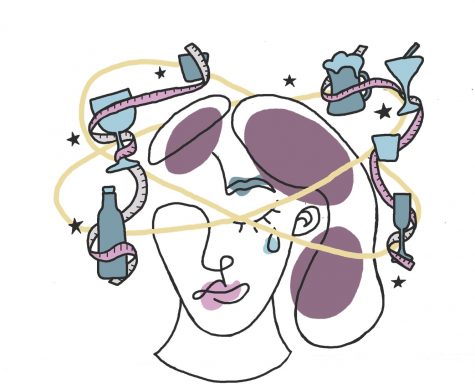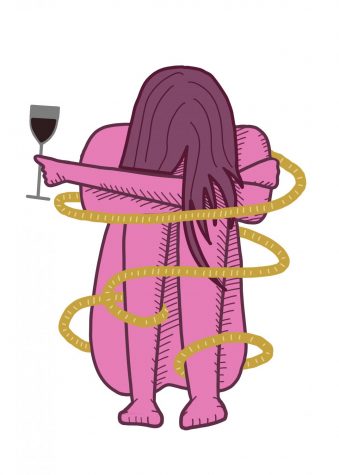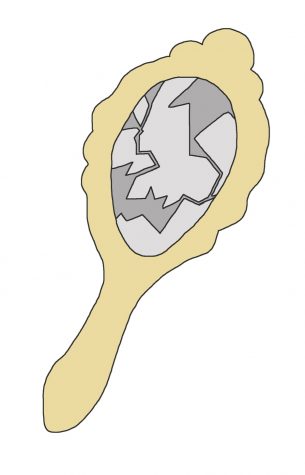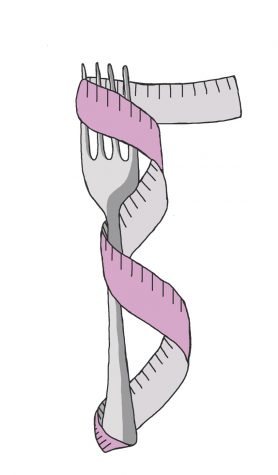
Overweight. Too skinny. Too curvy. Flat-chested. The never-ending flood of images online reflecting unrealistic beauty standards has created a detrimental environment where self-hate consumes some teenage girls. Social media posts, pressure from family members and peers and social anxiety are all factors that have contributed to the frequency of eating disorders among high school students. Constantly skipping meals to squeeze into an outfit, get intoxicated faster or cancel out calories from alcoholic beverages have all become common habits for some of those involved in the party scene. While they may start as conscious decisions, these lifestyle choices are eating disorders nonetheless, and can quickly spiral out of control without professional support.
According to the National Association of Anorexia Nervosa and Associated Disorders, anorexia nervosa, bulimia nervosa and binge eating disorders are the most prevalent eating disorder conditions among teenagers. Anorexia nervosa is characterized by a distorted self-image accompanied by a calorie deficit and dramatic drop in body mass; bulimia is defined as recurring episodes of binge eating followed by self-induced vomiting and sometimes extreme exercising; binge eating disorder entails eating without control and in large amounts at one time.
Corinne Dobbas, a Marin Nutrition and Body Image Counselor who has a master’s in nutrition science (MS) and is a registered dietitian (RD), reveals that, despite their traditional portrayal, eating disorders do not always mean that the person appears underweight, which makes them even more challenging to identify and treat.
“You cannot tell someone’s degree of suffering or mental health and the amount of pain that somebody is going through based on the size of their body or just by looking at them. Eating disorders thrive in secrecy. They are not contained within one body shape despite our culture’s precedent,” Dobbas said.
Even though around 9 percent of the U.S. population will have an eating disorder at some point in their life, those struggling often go unnoticed, and the Bay Area is no exception. According to a 2014 Bark survey, 32.5 percent of Redwood girls consider themselves to have had an eating disorder at some point, and 7.5 percent have been medically diagnosed.

Although the reasons for disordered eating vary, the illness can become particularly fatal when combined with alcohol and partying, a common practice among local teens. According to data from the 2019 California Healthy Kids Survey, almost half of Marin County’s 11th graders and more than a quarter of ninth-graders drink or use drugs. While eating disorders and alcohol abuse are two separate conditions, their common co-occurrence is rooted in both illnesses’ ability to temporarily mask stress, anxiety, fear, trauma or sadness, and together they can be a deadly mix. Because alcohol and restricted eating only diminish the aforementioned mental issues for a limited time, it can sometimes encourage people to continue engaging in destructive habits to replicate the same comfort. Those who struggle with both an eating disorder and a tendency to abuse substances demonstrate worse symptoms and worse outcomes than those with only an eating disorder, including increased medical complications, longer recovery time and a higher chance of relapse, according to the National Institute on Alcohol Abuse and Alcoholism.
Even if someone initially has no intention of eating in a disordered manner, these bad habits, normalized by party culture, are slippery slopes that can induce obsessive eating disorder behaviors, especially considering that teenagers are highly susceptible to addictive behaviors. The nucleus accumbens is the part of the brain that reacts with happy “reward” chemicals when people eat, sleep or do other things that ensure their survival. These chemicals can also be artificially produced when people engage in disordered eating habits. By consistently activating this section of the brain, the neurotransmitter solidifies, and a pattern is formed.
Once this habit is established, it is difficult to break, especially because most struggling individuals become reliant on the relief found from artificial stimulation. Even when presented with the devastating health consequences of eating disorders, it takes renewed effort to break the circuit of a person who is dependent on a false solution, emotional relief, comfort or stability.
In the initial months of struggling through anorexia, senior “Lucy,” who wishes to remain anonymous, used her relationship with food as a means of control over her body; however, as the illness progressed, managing her food became addictive. It was almost impossible to escape her compulsion to restrict.
“Since eating disorders are habitual, they become something you rely on to feel [in] control, to feel comfort [and] to feel good,” Lucy said. “You have this eating disorder voice in your mind telling you, ‘You can’t eat this. You can’t do that.’ It kind of sets of all these rules for you, and if you break them, it feels like you’ve lost that source of control, which is a scary feeling.”
Along with addiction, the danger behind these practices also lies in the individual not receiving enough calories or nutrients from food to maintain a healthy body. Although alcohol does contain calories, they are considered empty calories that provide no nutritional value. For those consistently depriving their bodies of adequate nutrition, the result is a high risk for dehydration, vitamin depletion and other health issues that lead to an electrolyte imbalance.

In addition to restricted eating, another dangerous party-instigated practice is self-induced vomiting after a night of heavy drinking to expel alcohol, which has been recently coined as “pulling trig.” Although the initial intention is not rooted in disordered eating, normalizing the act of intentionally throwing up can suck people into bulimic habits that follow them outside the party scene and into day-to-day life. According to a research study conducted by Tufts Medical School, purging behaviors can change an individual’s brain chemistry and become addictive if performed frequently. Forcing oneself to throw up on a consistent basis can shift serotonin levels and release endorphins into the brain, resulting in a high that people might strive to recreate following a meal.
Furthermore, intentionally throwing up can prompt extreme health-related consequences. Constantly vomiting can put someone’s body in a state of electrolyte imbalance, causing symptoms such as an irregular heartbeat, fatigue and seizures. Similar to anorexia, purging can cause an absence of a menstrual cycle, leading to infertility later in life.
Even though these behaviors have been normalized by some partygoers, it is crucial to understand that both alcohol and eating disorders are forms of addiction. When they occur simultaneously, they can be a catalyst to more severe mental and physical health issues. As someone who struggled through an eating disorder while still going to parties, Lucy affirms that engaging in these behaviors is not worth the risk of developing the illness.
“If I had to use one word to describe an eating disorder, it would probably be ‘addicting,’” Lucy said. “When you start acting on these normalized behaviors, it can be really hard to stop. Eventually, it becomes out of your control. No matter the excuse as to why you’re participating in an eating disorder-related behavior, it’s still a behavior and can escalate into something severe.”
Not only can the standardization of disordered eating habits manipulate people into developing an illness, but it can also worsen the experience of those presently struggling or recovering from an eating disorder themselves. Having struggled with issues regarding her relationship with food, St. Ignatius College Preparatory (SI) junior Charlotte Glen has experienced firsthand how difficult it is for those recovering to attend parties.
“I think the relationship between partying and eating disorders is a touchy subject for people in recovery because it can be very triggering. They may think, ‘Was I better when I restricted? Should I go back to doing that? Will I look better to people if I follow what they’re doing?’ It makes it easy to question yourself when you’re in a peer pressure situation,” Glen said.

Regardless of how society and popular culture view the ideal body size and appearance, unhealthy eating habits are extremely dangerous and potentially fatal when left untreated. As easy as it is to conform to party culture norms, Glen reiterates that people must continue to engage in behavior that keeps their bodies and minds healthy.
Considering the fragile state of those struggling with or recovering from an eating disorder Lauren Smolar, Senior Director of Programs for the National Eating Disorder Association (NEDA), stresses the importance of finding a support system that encourages safe habits.
“Surrounding yourself with people who also have an unhealthy relationship with food can make it incredibly challenging to recognize that it’s not healthy behavior or understand that you need to step back and surround yourself with more positive influences,” Smolar said.
Having experienced being around those that negatively influenced her eating behaviors, Glen created the Body Positivity club at SI with her friend and classmate Caroline Abrams to help those find the support she was initially looking for.
“At my school, I realized that no one really talked about body image and feelings that many girls have. [Abrams] and I thought that it was super important to bring support to our school and let people know they’re not alone. I know when I was in that situation, I felt like no one [understood] how I felt,” Glen said.
Despite their tendency to isolate people, eating disorders do not have to be fought alone. While party culture can normalize these illnesses, Dobbas emphasizes how important it is to seek professional support to begin the recovery process.
“Eating disorders are often a way people cope with uncomfortable feelings and uncomfortable emotions or maybe a past trauma,” Dobbas said. “Whatever the reason may be, there are people out there dedicated to supporting those who are struggling. Whatever practices that have been normalized because of partying or social media should not keep those who are struggling away from the help they need.”
If you or someone you know is exhibiting any eating disorder signs, contact the 24-hour National Eating Disorders Helpline at +1 (800)-931-2237. The Wellness Center is also available during school hours and can help connect you to local doctors, therapists or psychiatrists that specialize in eating disorder diagnosis and recovery. If you are unsure whether your eating habits qualify you for professional help, the National Eating Disorder Association also has a screening tool that can determine your diagnosis and subsequent treatment options. https://www.nationaleatingdisorders.org/screening-tool













